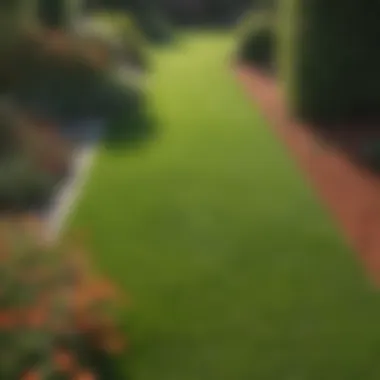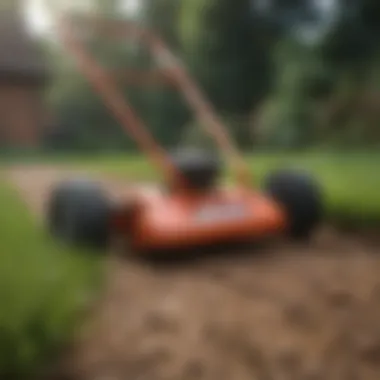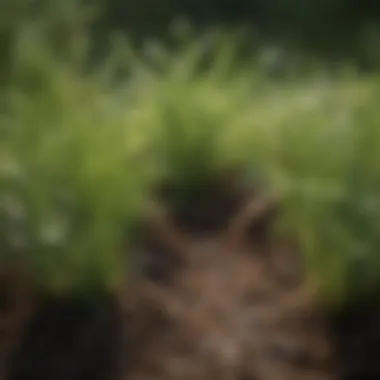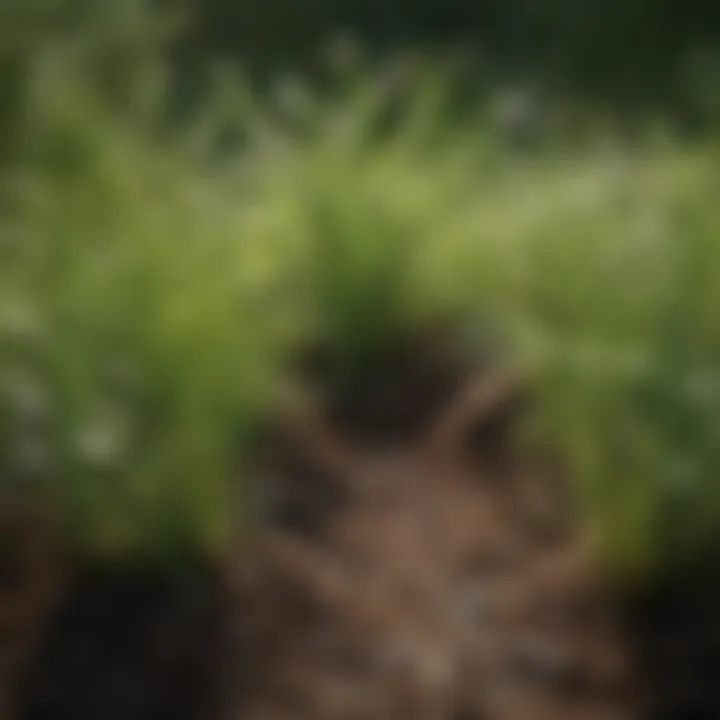When to Scarify Your Lawn for Optimal Growth


Intro
Lawn health hinges on a variety of factors, but one practice often overlooked by homeowners is scarification. It’s like giving your lawn a chance to breathe. This method, which involves removing thatch and moss, is crucial for encouraging growth and ensuring that nutrients penetrate into the soil. Knowing when to scarify is not just a matter of preference; timing can make or break the effectiveness of the process. To dive deeper into this topic, let’s explore the key insights and practical advice in detail, all tailored for gardening enthusiasts and homeowners who wish to elevate their outdoor spaces.
Key Insights and Trends
Understanding the best times to scarify can be compared to watching the seasons change. Each phase brings its own set of responsibilities. For those keen on keeping a lush lawn, here are some critical insights:
Seasonal Considerations
- Spring: As temperatures rise in late March and April, warmer weather encourages grass to grow. This is often touted as the prime time for scarification. However, it’s essential to wait until the grass is actively growing; scarifying too soon can damage roots still recovering from winter.
- Autumn: Just as spring leads to new life, autumn prepares the lawn for dormancy. Scarification in September and October can help the grass store nutrients for the colder months ahead. The soil remains warm, and the air retains moisture, creating ideal conditions.
Environmental Factors
Scarification isn’t a one-size-fits-all process. Local climate patterns, soil type, and even the specific strain of grass in your yard can influence decisions. Some areas may experience particularly wet or dry weather, changing the optimal timing. Here’s how different environmental conditions can affect the process:
- Moisture Levels: Wet soil is easier to work with, but too much moisture can lead to compaction issues. Always assess the soil before scarifying.
- Grass Type: Familiarizing yourself with your grass’s growth cycle can provide clarity on the best times for scarification. Some varieties thrive when scarified at different intervals.
Practical Tips and How-To Guides
Armed with insights, it’s time to roll up your sleeves and get into the nitty-gritty of scarification. Here’s a step-by-step guide:
Step-by-Step Instructions for Scarifying Your Lawn
- Check the Weather: The best days to scarify are dry but not too hot, ideally ranging from 15 to 25 degrees Celsius.
- Choose Your Tools: A lawn scarifier can be manual or powered. For smaller lawns, a rake could suffice, but larger areas may need a more robust solution.
- Mow Your Lawn: Before scarifying, mow the lawn to a shorter height to prevent damage during the scarification process.
- Scarify: Either follow the lawn's contour or make straight lines. Ensure you’re not going overboard—too deep can harm the roots.
- Rake Up Thatch: Post-scarification, gather up the debris to keep the lawn clean and healthy.
- Re-seed and Fertilize: Depending on the condition post-scarification, consider aerating and adding grass seed or fertilizer to promote regrowth.
- Water: Proper hydration is essential after the procedure.
"Scarification is like pressing a reset button on your lawn’s health. It’s all about timing and technique."
Recommended Resources
To learn more about maintaining a healthy lawn, consider visiting Wikipedia for in-depth articles or check out community discussions on platforms like Reddit for real-life experiences.
In summary, mastering the timing of scarification transforms your lawn into a robust ecosystem. By understanding the characteristics of your specific environment and following practical guidelines, you can ensure a verdant lawn that not only looks good but also thrives sustainably.
Intro to Lawn Scarification
Maintaining a lush and vibrant lawn is more than just frequent mowing and watering. One often overlooked practice that can significantly enhance the health and appearance of your lawn is scarification. Understanding this essential lawn care procedure is crucial for homeowners who aspire to achieve lush greenery.
Definition of Scarification
Scarification, at its core, involves the mechanical process of removing thatch and moss from the surface of the lawn. Thatch is a layer of dead grass and organic material that accumulates on the soil surface. When it builds up excessively, it can prevent air, water, and essential nutrients from reaching the roots of your grass. This, inherently, leads to a weakened lawn. Scarification is done using a specialized machine called a scarifier, which works much like a rake but more effectively. It essentially slices through the thatch and lifts it from the lawn, promoting better air circulation.
Purpose and Benefits
The benefits of scarification are manifold. Firstly, it encourages healthier grass growth. By removing the debris that blocks sunlight and hinders moisture absorption, your lawn can receive the care it needs to thrive. Moreover, scarification helps reduce soil compaction, allowing roots to spread and strengthen.
Secondly, it can enhance the overall appearance of your lawn. A well-scarified lawn is more uniform and green, contributing to that coveted curb appeal. Regularly scarifying can also lead to improved resilience against pests and diseases because a healthier lawn naturally has better defenses.
"A healthy lawn is a happy lawn. Scarification paves the way for a robust growth cycle."
Also, by addressing the thatch build-up, scarification can improve drainage, reducing the risk of water pooling on your grass during rainy periods. Additionally, when done in preparation for seeding, it allows new seeds to make better contact with the soil, significantly boosting germination rates. Understanding the timing and benefits of scarification is essential for homeowners looking to enhance their lawn care practices.
Understanding Your Lawn
Gaining an in-depth understanding of your lawn is a heart of effective lawn care, especially when considering scarification. This encompasses not just the type of grass present but also its specific needs and the signs that might indicate it’s time for a good scarification session. By being attuned to these elements, homeowners can ensure their lawns are thriving rather than merely surviving.
Grass Types and Their Needs
Different types of grass have unique requirements based on their growth patterns, climate adaptability, and seasonal preferences. For instance:


- Cool-season grasses like Kentucky bluegrass or fescues thrive in the cooler months, often showing robust growth in early spring and fall. They require scarification during these optimum growth times to aerate the soil and boost nutrient absorption. Noting when your grass type is most active assists in timing the scarification appropriately.
- Warm-season grasses, such as Bermuda or zoysia, prefer the heat of summer. Their growth spurt occurs later in the year, meaning scarification is best suited for late spring or early summer when the grass can recover quickly after the process. Understanding these periods leads to a well-timed intervention that supports healthy growth.
Getting familiar with the specifics of your lawn's composition is vital; it can mean the difference between a lush field of grass and a struggling patch of ground.
Signs Your Lawn Needs Scarification
There are several telltale signs that your lawn may be in need of scarification. Without this maintenance, your grass could become choked by thatch—a layer of dead and living organic matter sitting above the soil. Here are some common indicators that it's time to take action:
- Thick Thatch Layer: When the thatch layer exceeds half an inch, it's a red flag. Lawns can suffocate under such conditions, which prevents water and nutrients from reaching deeper roots.
- Poor Drainage: If your lawn tends to hold water, it can be sign of compaction or thatch buildup. Water pooling on the surface can harm the grass and invite pests.
- Lackluster Growth: Even with regular watering and fertilization, if your lawn is looking patchy or undernourished, it might be crying out for some scarification.
- Increased Pest Activity: For some insects, such as grubs or beetles, untreated thatch can create a breeding ground. Keeping your lawn healthy and properly aerated helps control potential infestations.
"A well-maintained lawn not only looks better but also contributes to the overall health of the surrounding ecosystem. Broken down, your lawn is a barometer of soil health."
Being proactive and attentive to these signs not only preserves the vitality of your lawn but also sets the stage for a flourishing environment that can support life and beauty in your outdoor space. A healthy lawn isn't merely aesthetic; it’s a haven for local wildlife and a sanctuary for the senses.
Timing Considerations
Understanding the timing considerations in lawn scarification is paramount for achieving a lush and healthy lawn. Just like people, grass has its own natural rhythms, and aligning the scarification process with these rhythms can significantly boost the health of your turf. Poor timing can lead to stress on the grass, making it vulnerable to pests and diseases. A well-timed scarification not only promotes air circulation and nutrient uptake but also prepares the lawn for the demanding seasons ahead.
Additionally, the right timing can reduce the amount of excess thatch accumulation, improving the overall aesthetics of your sod. The implications of timing in this context extends beyond just aesthetics—timing can dictate the success of your lawn care practices, helping you maintain optimal conditions for growth, resilience, and vitality.
Seasonal Factors in Lawn Care
Each season brings with it unique factors that can affect lawn care practices. It's crucial to observe how seasonal changes influence grass growth and health. In spring, for instance, grass begins to wake up from its winter slumber. This rejuvenation period is when nutrients should be readily available, making it an ideal time for scarification. On the flip side, autumn signals a slowing down of growth, offering a chance to prepare grass for the colder months.
Weather conditions, such as rainfall and temperature fluctuations, should also be taken into account. Milder temperatures can encourage grass growth, while extreme heat or cold can stunt development and recovery.
Optimal Times for Scarification
Spring Scarification:
Spring is generally regarded as a golden opportunity for scarification. As the temperatures gradually rise, grass enters its active growth stage, making it better equipped to recover from the process. One key characteristic of spring scarification is its alignment with grass’s natural growth cycle. It's the beginning of the growth period, so the grass can bounce back quickly.
When scarifying in spring, the soil is typically moist from winter's snowmelt or rain, helping the scarifiers to penetrate the ground more effectively. However, if the ground is too wet from prolonged rain, this might lead to soil compaction instead of alleviation. Scarification during this period also encourages the infiltration of sunlight and nutrients, imparting significant benefits to the lawn. Nevertheless, timing matters; aim to schedule the task after the last frost to ensure the grass has the best chance to recover.
Autumn Scarification:
Now, switching gears to autumn scarification, this option is equally important. The principal advantage of scarifying in the fall is the preparation it affords for winter dormancy. Here, the key characteristic lies in its timing—autumn scarification sets the stage for spring growth.
During this period, grass is still actively growing but is gearing down as the cooler weather approaches. Scarifying at this point can expose the earth to nutrients and water while also mitigating thatch buildup, ensuring the lawn is in peak condition for the winter months. However, one must be cautious to avoid late-season scarification if temperatures plummet, as this can hinder the lawn's recovery. Timing is crucial; early-to-mid fall is generally the best window for this practice.
Local Climate Influences
Local climate can dramatically alter the timing of lawn scarification. Different regions experience varying temperatures and precipitation patterns that influence grass's growing conditions. In areas with milder winters, for instance, the timing may shift slightly, allowing for scarification at different points in the spring or even early winter.
Conversely, regions with harsh winters might necessitate a tighter window for scarification, emphasizing an earlier autumn schedule to prepare the grass for dormancy. It’s important to adjust practices based on local environmental cues and grass type adaptability. Keeping an eye on local weather forecasts can help homeowners identify the suitable times for scarification, thus optimizing results.
Pre-Scarification Preparation
Preparing your lawn for scarification is a crucial step in ensuring that the process yields the best possible results. Without the right groundwork, you risk undermining the benefits that scarification can offer. By assessing the current state of your lawn and making necessary adjustments before you start, you'll be setting the stage for a healthier, greener lawn. The importance of this preparation phase can't be overstated—it not only maximizes the impact of scarification but also protects your lawn from potential damage.
Lawn Assessment and Care
Assessing your lawn before diving into scarification involves a few key steps. You need to understand its current health and condition, which informs your approach moving forward.
Mowing Before Scarification
Mowing before scarification is not just a recommended practice; it's a vital pre-step that can greatly enhance the effectiveness of the scarification process. Mowing your lawn to a shorter length—typically around 1.5 to 2.5 inches—ensures that the scarifier can reach down to the thatch layer without battling through overly tall grass. This aspect of preparation is particularly beneficial because it lays a clear path for the scarification blades, making them more effective at loosening compacted soil and removing excess thatch.
By cutting the grass short, you create a more uniform surface, which leads to a more consistent scarification treatment. However, there’s a unique nuance here: if you mow too close, you might expose the underlying grass roots, putting them at risk of stress. Thus, finding the right mowing height is a balancing act that requires attention and care.
Watering Requirements
Watering is another critical aspect to consider before scarification. Ideally, the soil should be moist—not overly saturated—when scarifying. This moisture makes the soil more pliable and allows the scarifier to easily penetrate and break up the thatch layer. Too dry, and both the blades and the potential benefits of scarification become compromised. If the soil is left too wet, you risk causing damage to your grass or even tearing up plugs of soil.


A common approach is to water the lawn the day before you plan to scarify. This allows the water to soak in a bit while not leaving the surface muddy. It's also wise to monitor weather conditions prior to this step. If it has recently rained, you may not need to add additional water, and if the weather forecast predicts rain in the days following the scarification, you might want to hold off until that clears up.
Tools and Equipment
The effectiveness of scarification relies heavily on the tools and equipment you choose. Having the right tools makes a difference in how well you can execute the process. Whether you’re going for a manual or motorized scarifier, your choice should align with the size of your lawn and your comfort level with the equipment.
Here are a few tools and equipment considerations to keep in mind:
- Scarifiers: With choices ranging from electric to gas-powered options, your selection may depend on the size of your yard and your budget. Electric scarifiers are usually lighter and quieter, making them suitable for smaller lawns, while gas-powered models tackle larger areas faster.
- Rakes and Aeration Tools: These can support the primary scarification process by helping to gather debris and aerate the soil beforehand.
- Protective Gear: Always consider using gloves, goggles, and closed-toe shoes while operating machinery. Though it may seem minor, being protected from flying debris or sharp edges can save a lot of hassle.
By taking these preparation steps seriously, you're not just going through the motions. You're laying the groundwork for a more effective scarification process, ultimately promoting a healthier, more vibrant lawn.
Executing the Scarification Process
Embarking on the journey of executing lawn scarification is not just a task to check off your to-do list; it’s a crucial method to revitalize your lawn, ensuring it remains bouncy and lush. Scarification removes thatch and enhances airflow, allowing nutrients and water to penetrate deeper into the soil. The benefits of this process ripple through your lawn health, encouraging stronger grass growth and reducing challenges like pests and diseases. However, understanding how to do it properly is essential so as not to do more harm than good.
Step-by-Step Guide
Step 1: Choose the Right Time
Timing is key in scarification. Ideally, you should tackle the task during the active growing periods of your grass—early spring or early autumn. The grass will recover quicker after the process.
Step 2: Prepare the Lawn
Before diving in, mow your lawn. Aim for a height of around 30-40mm. This lower height allows the scarifiers to reach the thatch effectively. Following this, ensure your lawn is dry, as a soggy lawn can make the process less efficient.
Step 3: Select Your Tools
Using a scarifier—whether manual or motorized—will significantly impact the effectiveness of the process. Adjust the settings according to the condition of your lawn. A more aggressive setting may be suitable for lawns with heavy thatch, while a gentler approach works for less compacted grass.
Step 4: Start Scarifying
Begin at one edge of your lawn and work methodically in straight lines or overlapping passes. This technique allows each area to be effectively scarified without missing spots. Pay close attention to particularly thick areas of thatch or moss, as these may require you to go over them more than once.
Step 5: Clean Up
After you've completed the scarification, rake up all the debris left behind. Leaving thatch and moss on the lawn might suffocate the grass as it attempts to revive.
Take your time during this step; rushing can lead to tired arms but better results come with a little labor.
Post-Scarification Care
What comes after scarification plays just as much of a part in your lawn’s health as the scarification itself. It’s during this stage that your lawn can have an opportunity to recover and flourish.
Fertilization
Fertilizing your lawn post-scarification is a key strategy. Grass thrives on nutrients, and after such a demanding process, giving it a boost is essential. A balanced fertilizer—one that includes nitrogen, phosphorus, and potassium—helps to promote new growth and assists in recuperation. The unique aspect of using fertilizers right after scarification is that it'll help to fill in any patches that may have been damaged during scarifying. For example, many homeowners prefer granular fertilizers because they are easy to apply evenly. However, liquid fertilizers might be better for lawns needing a quick nutrient uptake.
Watering
Proper watering is another essential after the act of scarification. The lawn should have a deep watering regimen—this helps in settling the soil and encourages the grass roots to dig deeper. The key characteristic is to water thoroughly, but avoid making the ground soggy. A good practice is to water right after scarification, giving the soil moisture it craves to recover effectively. Watering helps activate the nutrients released by fertilizers, making them readily available to the grass, thus promoting growth. However, too much watering can encourage diseases; striking a balance is fundamental.
Remember, these two steps—fertilization and watering—are vital to your lawn's recovery and overall vitality. Managing these post-scarification tasks carefully will lead your lawn from being tired and ragged to fresh and full of life.
Common Mistakes to Avoid
Lawn scarification is not just about running a machine over your grass; it’s a nuanced process that can truly benefit from a bit of know-how. Understanding the common mistakes associated with scarification can save you a mountain of grief and help preserve your lawn’s health. There’s no sense in digging a hole for yourself, figuratively speaking, so let’s dive in and unearth some of the common pitfalls to dodge when undertaking this crucial task.
Over-Scarification Risks


When it comes to scarifying, more isn’t always better. Over-scarification can emerge as a sneaky foe, wreaking havoc on your grass. Too much scarifying leads to stripping away not just the thatch, but also crucial nutrients and soil stability. You might find yourself left with more bare spots than green, which will take longer to recover than you’d imagine.
Symptoms of over-scarification include:
- Excessively bare patches that expose soil or roots.
- Weak and thin growth after the scarifying process.
- Susceptibility to weeds due to compromised lawn health.
To prevent these issues, it’s wise to assess your lawn’s condition beforehand. A quick check can give insights into how much thatch and debris you truly have. For most grasses, a good rule of thumb is to scarify no more than once or twice a year.
"Scarifying is more art than science; balance is key to a thriving lawn."
Ignoring Weather Conditions
Weather plays an all-too-important role in lawn care, and scarification is no exception. Ignoring local climate patterns may result in inadequate results, leaving your lawn in a bit of a tizzy. Scarifying during the wrong time could lead to your lawn being exposed to stressors — heightened heat, torrential rain, or unexpected frost, just to name a few.
Consider these weather aspects:
- Humidity Levels: High humidity can impair correct repair after scarifying.
- Precipitation: Scarifying before rain can lead to muddy messes, while waiting too long might deprive the lawn of necessary moisture.
- Frost and Cold Spells: Scarifying when temperatures are low can shock your grass, resulting in long-term damage.
Before diving into the task, take a minute to check the weather forecast. Aligning your scarification with favorable conditions can mean the difference between a lush lawn and one that leaves you scratching your head.
In summary, avoiding these common mistakes can significantly enhance the effectiveness of your lawn scarification efforts. By being mindful of over-scarification and the ever-important weather conditions, you can preserve your lawn’s integrity, leading to a greener and healthier space in your garden.
Long-Term Lawn Health
Maintaining a lawn is not just about keeping it green during the sunny months. Long-term lawn health is vital for sustaining an attractive landscape and ensuring your grass thrives year after year. Regular practices like scarification contribute significantly to the overall wellbeing of your lawn by fighting issues like compaction, thatch buildup, and improving aeration and drainage.
Scheduling Future Scarification
To keep your lawn in tip-top shape, scarification isn’t a one-and-done task. Instead, it should be an integrated part of your lawn care schedule. Timing plays a pivotal role here. Setting a regular scarification schedule—usually every one to three years depending on your lawn’s condition—ensures that the grass roots have enough room to breathe and absorb nutrients efficiently. Don't wait until your lawn looks like a patchy mess; regular assessment is key.
Integrating with Other Lawn Care Practices
Scarification should be part of a broader lawn health strategy. Integrating it with practices like aeration and seeding creates a robust ecosystem for your grass to flourish.
Aeration
Aeration involves perforating the soil with holes to allow air, water, and nutrients to penetrate the grassroots. It helps alleviate soil compaction, a common issue that can suffocate your grass over time. Aeration, especially when done before seeding or fertilization, ensures that nutrients can reach the core of the soil where they are most needed. It becomes a popular choice among homeowners who want to rejuvenate older lawns. A unique feature of aeration is its adaptability; it can be performed in most climates, making it a universal solution. Notably, however, it can temporarily make your yard look a bit messy, but the benefits greatly outweigh this short-term inconvenience.
Seeding and Fertilization
After scarification, seeding and fertilization can be incredibly beneficial. When you incorporate new seeds into the freshly scarified soil, it gives them a better chance to germinate and thrive. Fertilizing around the same time can provide the young seedlings with the necessary nutrients for healthy growth. The key characteristic here is the synergy between these practices; they work hand in hand to develop a fuller, denser lawn over time.
One unique aspect of seeding is selecting the right type of grass seed for your region and lawn conditions. There’s a bit of homework involved to ensure you pick the seed that will best adapt to your environment. While the advantages of seeding and fertilization are clear, some drawbacks exist, such as potential over-fertilization, which can lead to thatch issues, and the need for precise timing to correspond with weather patterns to ensure successful growth.
Remember: Consistency in your lawn care regimen will lead to a healthier, greener outcome over time. Your lawn will thank you with lush growth and superb resilience against various environmental stresses.
Ending
Understanding the optimal timing for lawn scarification is critical for the long-term health and vibrancy of your yard. This practice, while often overlooked, can significantly enhance your lawn's resilience against various environmental stressors. Scarification helps to tackle thatch buildup, improves air circulation, and boosts nutrient absorption. Each of these benefits plays a key role in cultivating a lush, green lawn that you're proud to showcase.
The timing of your scarification efforts correlates deeply with the growth cycle of grass and the seasonal climate of your region. Performing scarification during the most suitable moments, such as in spring or autumn, will yield the best results and foster rejuvenation. Remember, good preparation before you start is equally important, aligning with local climate considerations and the specific needs of your lawn.
It’s about striking a balance—overdoing it can lead to damage but avoiding it altogether may leave your lawn weak and patchy. Thus, observing signs of water stress, compacted soil, or thatch thickness should guide your timing decisions. Furthermore, integrating scarification with other lawn care practices, such as fertilization and aeration, will compound benefits and lead to a thriving ecosystem in your garden.
"Timing is everything. Don't overlook its importance when it comes to caring for your lawn."
Recap of Key Points
- Scarification timing matters: The best times typically are spring and autumn, aligned with the growth cycle of your grass type.
- Preparation is essential: Before scarifying, ensure your lawn is mowed and well-hydrated to maximize the effectiveness of the process.
- Monitor your grass: Signs that indicate your lawn needs attention include excessive thatch, compacted soil, or general poor health.
Encouragement for Lawn Enthusiasts
Gardening isn't just a hobby; it's a journey. For all the homeowners and gardening enthusiasts out there, embrace the process of lawn care with enthusiasm and patience. Every effort you put in, from the meticulous timing of scarification to the nurturing of your grass, contributes to creating a beautiful outdoor space you can enjoy.
So get ready to roll up those sleeves, apply these insights, and don't hesitate to experiment a bit. Each lawn is unique, and understanding its needs will help you achieve that coveted, lush look. Remember, the more you invest in learning about your lawn, the more rewarding the results will be. Keep a keen eye on the seasonal changes, and take pride in the vibrant green landscape you cultivate.



